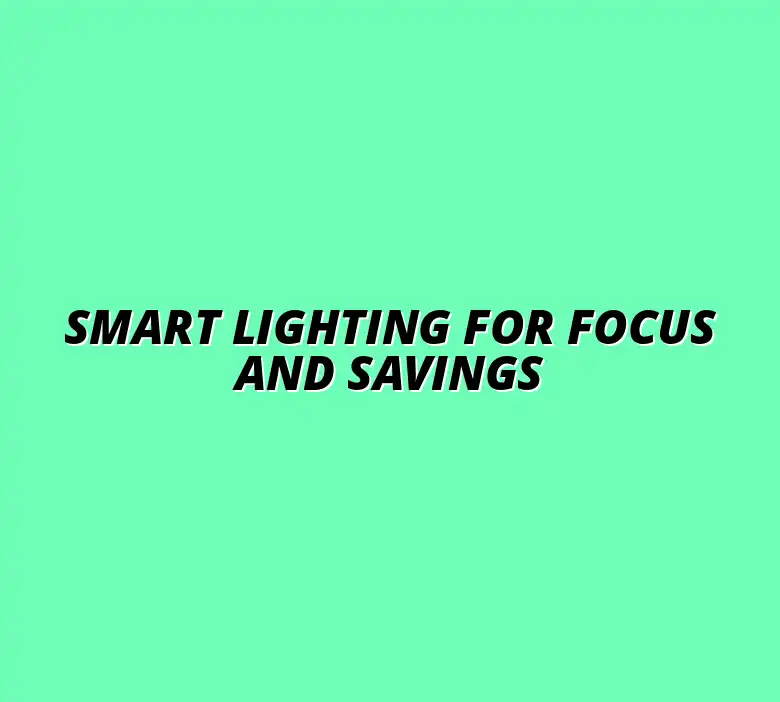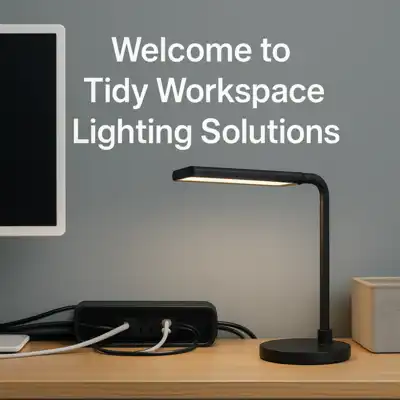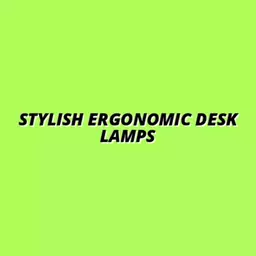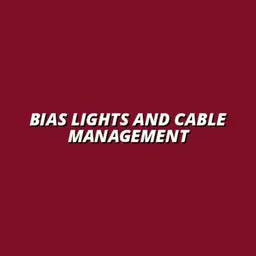Smart Lighting for Focus and Savings
In an age where energy efficiency and productivity are paramount, smart lighting isn't just a trend—it's a necessity for modern living. By embracing smart lighting technologies, we can enhance our workspaces and our overall quality of life.
What You Will Learn
- Energy Efficiency: Smart lighting systems utilize sensors and automation to significantly reduce energy consumption.
- Customizable Ambiance: Adjust light colors and brightness to suit your mood or activity, enabling a more personalized environment.
- Focus Enhancement: Properly optimized lighting can improve concentration and productivity by reducing distractions.
- Advanced Automation: Light scheduling, motion sensors, and remote control features maximize convenience and efficiency in your workspace.
- Health Benefits: Human-centric lighting mimics natural light patterns, promoting well-being and reducing eye strain.
- Future Innovations: The integration of AI into smart lighting will enable systems to adapt to your daily routines and preferences.
Benefits of Smart Lighting Automation
Smart lighting not only enhances productivity but also significantly contributes to energy savings. Below are the key benefits represented visually:
Energy Savings
- Up to 50% reduction in energy bills with smart lighting systems.
- Use of motion sensors for automatic light management.
- Remote control capabilities to adjust lights from anywhere.
Productivity Enhancements
- Improved focus with optimized lighting.
- Reduced eye strain during work sessions.
- Enhanced creativity through appropriate ambiance.
Smart Lighting Features
- Light scheduling automation
- Integration of LED technology
- Dimming capabilities for task-specific lighting
Understanding the Role of Smart Lighting in Energy Efficiency and Focus Enhancement
Smart lighting technology is reshaping our home environments in exciting ways! With its ability to combine aesthetics and functionality, smart lighting promotes sustainable living while enhancing our daily routines. As someone who has dived deep into the world of workspace design at Tidy Workspace Lighting Solutions, I've witnessed firsthand how these innovative solutions can transform not just our homes, but especially our workspaces.
Imagine being able to control your lights from your smartphone or set them to automatically adjust based on the time of day. This not only adds convenience but also ensures that we’re using electricity wisely. By integrating energy-efficient smart lighting systems, we can create an environment that fosters productivity without the guilt of high energy bills!
The Importance of Smart Lighting in Modern Homes
Today, smart lighting is becoming an essential part of modern homes, offering more than just illumination. These systems can adjust their brightness and color temperature to complement our activities, whether it's working, relaxing, or entertaining. Not only does this adaptability enhance our comfort, but it also supports sustainable practices by reducing energy waste.
When I think about the homes I help transform, I see how smart lighting can lead to a more enjoyable living experience. It’s not just about having the right kind of light; it’s about creating a harmonious environment that encourages well-being and productivity!
- Energy Efficiency: Smart lighting uses sensors and automation to minimize energy consumption.
- Customizable Ambiance: Adjust colors and brightness to match your mood or activity.
- Remote Control: Change settings from anywhere using your smartphone!
Connecting Energy Savings with Enhanced Focus
One of the most exciting aspects of smart lighting is its correlation with productivity. When our lighting is optimized, we tend to focus better and work more efficiently. Think about those moments when you're squinting at your screen because the light is too harsh or dim! Smart lighting allows us to create the ideal atmosphere that supports our tasks.
At Tidy Workspace Lighting Solutions, we often recommend lighting setups that mimic natural light patterns. This not only helps in reducing eye strain but also keeps our energy levels steady throughout the day. Have you ever noticed how a well-lit room can uplift your mood and keep you motivated? That’s the magic of smart lighting!
- Improved Concentration: Proper lighting reduces distractions and keeps you focused.
- Reduced Eye Strain: Adjusting light levels helps avoid discomfort during long work sessions.
- Enhanced Creativity: A well-lit space can inspire fresh ideas and improve problem-solving.
Exploring Five Key Smart Lighting Automations for Home Offices
After understanding the importance of smart lighting, let's dive into some practical automations that can elevate your home office experience! These setups not only enhance your workspace but also promote energy efficiency and focus:
- Light Scheduling Automation: Set your lights to turn on and off automatically based on your work hours.
- Utilizing Motion Sensors: Lights turn on when you enter the room and off when you leave!
- Integrating LED Technology: Use energy-saving LEDs that last longer than traditional bulbs.
- Remote Control Features: Adjust your lighting from anywhere with your smartphone.
- Dimming Capabilities: Customize brightness levels based on your tasks.
Each of these automations can significantly boost your productivity and contribute to a clutter-free workspace. So, are you ready to let smart lighting illuminate your path to a more efficient and enjoyable workday? Let’s shine a light on your home office together!
💡 Looking for a cable-free lighting setup? See how wireless solutions fit into a clutter-free desk. 👉 Explore the Wireless Alternatives Guide
Quick Summary
Here's a brief recap of the key points discussed so far:
- Smart lighting technology enhances both energy efficiency and productivity in modern homes and workspaces.
- Properly optimized lighting can improve focus, reduce eye strain, and inspire creativity.
- Innovative automations, such as light scheduling and motion sensors, significantly boost workspace efficiency.
Future Trends in Smart Lighting Technologies
As we look toward the future, the world of smart lighting is rapidly evolving! Exciting innovations promise to enhance not only our focus but also energy efficiency in remarkable ways. From adaptive systems that respond to our daily rhythms to advanced automation features, the future of lighting is bright—pun intended!
One emerging trend is the integration of artificial intelligence (AI) into smart lighting systems. AI can learn our preferences and patterns, adjusting the lighting based on our daily activities. Imagine walking into your home office, and the lights automatically adjust to the perfect brightness for your current task. It’s as if the lights know you personally!
- AI-driven adaptive lighting systems
- Integration with voice-activated assistants
- Enhanced energy monitoring features
Another trend involves the rise of human-centric lighting, which focuses on the health benefits of lighting. This innovative approach mimics natural light patterns throughout the day, promoting well-being and enhancing focus. At Tidy Workspace Lighting Solutions, I believe that creating a workspace that prioritizes health and productivity is vital. So, let's keep an eye out for these advancements!
FAQs About Smart Lighting Automations
Curious about smart lighting automations? You're not alone! Many people have questions about how to set up these systems effectively and maximize their benefits. Here are some of the most common questions I encounter, along with straightforward answers.
How do I set up smart lighting?
Start with a reliable app and ensure your lights are compatible. Follow the instructions for connection, and you’ll be ready to go!
Can smart lighting help save energy?
Absolutely! By automating lights based on your schedule and using sensors, you can significantly cut down on energy consumption. You can see how smart lighting can play a role in energy efficiency.
What types of smart bulbs are the best?
Look for LED smart bulbs with a good reputation for longevity and brightness. They offer excellent energy efficiency and come in various styles!
Understanding these features can really transform how you interact with your lighting! If you have more questions, feel free to reach out. I’m always here to help guide you through your smart lighting journey.
Summarizing the Benefits of Smart Lighting Automation
Recap of Energy Savings and Productivity Enhancements
In this article, we've explored how smart lighting not only saves energy but also enhances productivity. From the use of automated scheduling to energy-efficient LED technology, we’ve seen that smart lighting solutions are truly game-changers. Remember, it’s all about creating the right ambiance that works for you!
As someone who is passionate about workspace design, I find it exciting to think about how these technologies can help individuals achieve a balanced and productive work environment. So let's keep these benefits in mind as we move forward with our lighting choices.
Exploring the Role of Energy Monitoring in Smart Lighting
Energy monitoring is another important aspect of smart lighting that contributes to sustainability. With energy tracking features, you can gain insights into your consumption patterns, helping you make informed decisions about your lighting usage. Not only does this lead to savings, but it also promotes an eco-friendly lifestyle.
Using energy monitors can be as simple as downloading an app or utilizing built-in features in your smart lighting system. The more informed you are, the better choices you can make! For those of us committed to creating a tidy and efficient workspace, this is a fantastic advantage.
Recap of Key Points
Here is a quick recap of the important points discussed in the article:
- Energy Efficiency: Smart lighting systems minimize energy consumption through sensors and automation.
- Customizable Ambiance: Adjust brightness and color temperature to enhance mood and support various activities.
- Remote Control: Control your lighting settings from anywhere using a smartphone for added convenience.
- Improved Concentration: Optimized lighting reduces distractions and enhances focus during work.
- Reduced Eye Strain: Proper light levels prevent discomfort, allowing for longer and more productive work sessions.
- Light Scheduling Automation: Automate your lighting to turn on or off according to your work schedule.
- AI Integration: Future smart lighting technologies may include AI for adaptive lighting based on user preferences.
- Human-Centric Lighting: New trends focus on mimicking natural light patterns to promote health and well-being.







